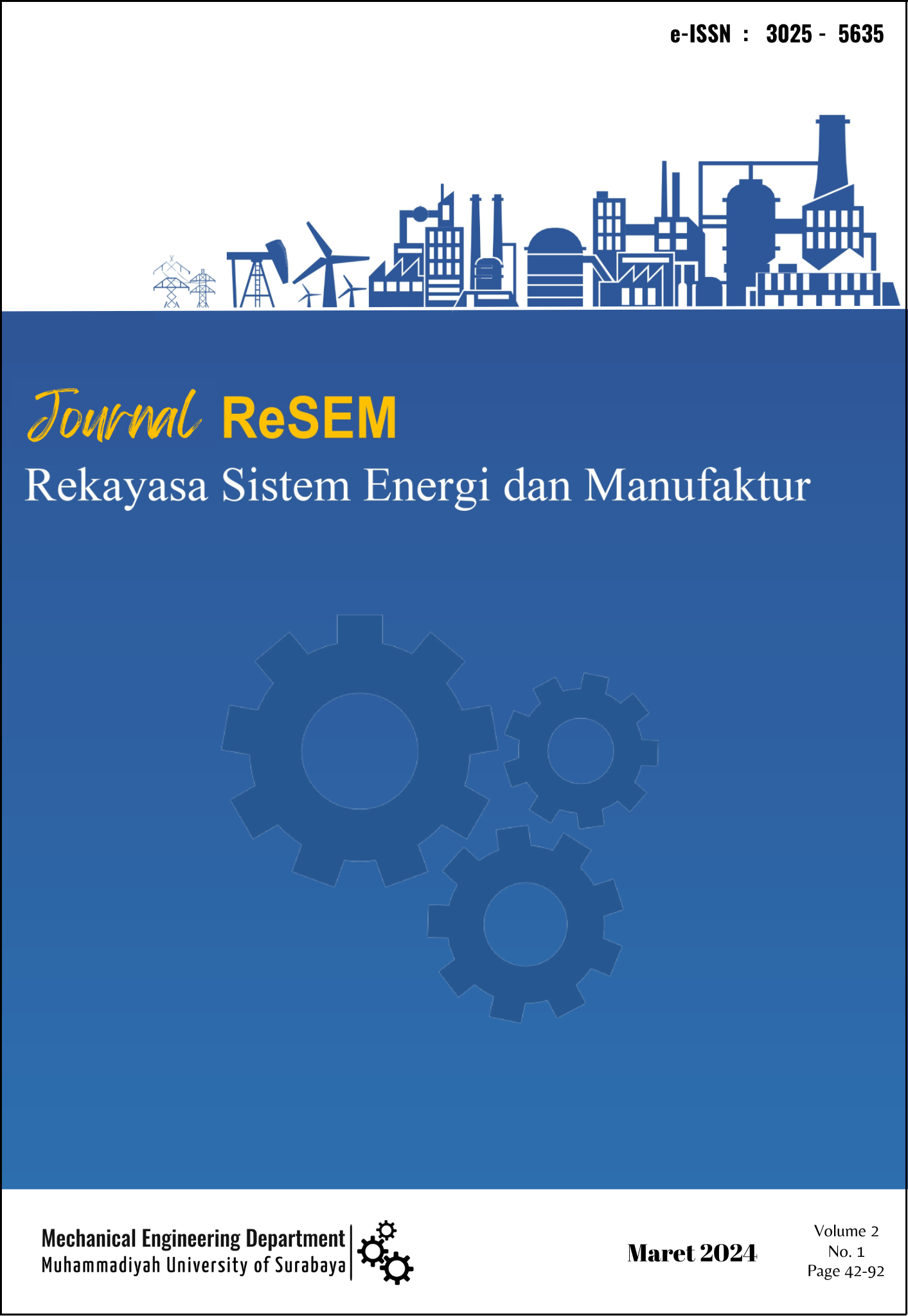REDESIGN OF BRAKE COOLING DUCT ON MOTORCYCLE FRONT DISC BRAKES; ANALYSIS OF TEMPERATURE CHANGES COMPUTATIONAL FLUID DYNAMICS (CFD) METHOD
DOI:
https://doi.org/10.30651/resem.v2i1.21924Abstract
Brake Cooling Duct is a useful technology to drain air from the front so that the brake caliper & brake disc do not overheat. Another benefit is to keep the engine temperature normal because the it always gets fresh air.
This study adds an air duct design or brake cooling duct to cool the brake disc using ANSYS CFD simulation with speeds of 48 Km/h and 98 Km/h to get the temperature of the brake disc when braking without cooling duct and using brake cooling duct, the difference in heat flux value after adding air duct/brake cooling duct, the process of temperature changes that occur when the air flow from the brake cooling duct touches the surface of the brake disc with speeds of 48 Km/h and 96 Km/h.
The results obtained brake disc temperature when braking without cooling duct with a maximum temperature value of 137.74 ºC and using brake cooling duct with air inlet speed of 48 Km/h is a maximum of 74.73ºc and 98 Km/h is 73.42 ºc. There is a difference in heat flux value after adding an air duct / brake cooling duct of 33116 W/m2 with a speed of 48 Km/h and 33746 W/m2 with a speed of 96 Km/h. The temperature change that occurs when the air flow from the brake cooling duct touches the surface of the brake disc with a speed of 48 Km/h is 58.97º C, for a speed of 96 Km/h is 60.26º C.
Keywords : Brake cooling duct , CFD, heat transfer, simulatioan temperature disk brake
References
Anurag Dey, 2015. (2015). Thermal Analysis of Disc brake in Order To Study. December.
Balasubramanyam, N. (2014). Design and Analysis of Disc brake Rotor for a Two Wheeler. International Journal of Mechanical and Industrial Technology, 1(1), 7–12.
Çengel, Y. A., Cimbala, J. M., & Turner, R. H. (2017). Fundamentals of fluid-thermal sciences. In Fundamentals of Thermal Fluid Sciences.
Daniel Das.A, Christo Reegan Raj.V, Preethy.S, R. B. . (2023). Structural and thermal analysis of disc brake rotor. AIP Conference Proceedings, 2754(1). https://doi.org/10.1063/5.0167373
Ducati Motor Holding S.p.A. (n.d.). Ducati Corse.pdf.
Hugar, D. S., & Kadabadi, P. U. B. (2017). Design and Thermal Analysis of Disc brake for Minimizing Temperature. International Research Journal of Engineering and Technology(IRJET), 4(7). https://irjet.net/archives/V4/i7/IRJET-V4I7687.pdf
Incroperara, F. P. and D. P. Dewitt, T. l. bergman, A. S. lavine. (2006). Free Convection. In Fluid Mechanics and its Applications (Vol. 112). https://doi.org/10.1007/978-3-031-28920-0_19
Khatami, M., Muslim, Z. A., & Kurniawan, Y. J. (2023). Design of brake failure control on motorcycle disc brake s through an integrated cooling system. Journal of Engineering and Applied Technology, 4(2), 106–114. https://doi.org/10.21831/jeatech.v4i2.65235
Raja, T., Mathiselvan, G., Sreenivasulureddy, M., & Goldwin Xavier, X. (2017). Design and analysis of Air flow duct for improving the thermal performance of disc brake rotor. IOP Conference Series: Materials Science and Engineering, 197(1). https://doi.org/10.1088/1757-899X/197/1/012086
Sarkar, S. (2013). Review Paper on Thermal Analysis of Ventilated Disc brake by Varying Design Parameters. International Journal of Engineering Research & Technology, 2(12), 1077–1081.
Shah, R., Shah, C., & Thigale, S. (2017). Design and analysis of a hydraulic Brake caliper. International Journal of Mechanical Engineering and Technology, 8(5), 33–41.
Shaik, A. F. B., & Srinivas, C. L. (2012). Structural and thermal analysis of disc brake with and without crossdrilled rotar of race car. International Journal of Advanced Engineering Research and Studies (IJAERS), Volume IV(Issue July-Sept), pp 39-43.
Singh, M., Pal, D., & Sen, N. (2022). Understanding and improving the brake cooling in disc brake s. 9(2), 309–321.
Fikri, Indra.2020.” Mantap! Ini Dia Regulasi Teknik Balap Motor Road Race Kejurnas Oneprix dan MotoPrix 2020”, https://www.motorplus-online.com. Diakses 20 November 2023
Jones, R.M. (1999). Mechanics of Composite Materials Second Edition. London: Taylor and Francis Group.









